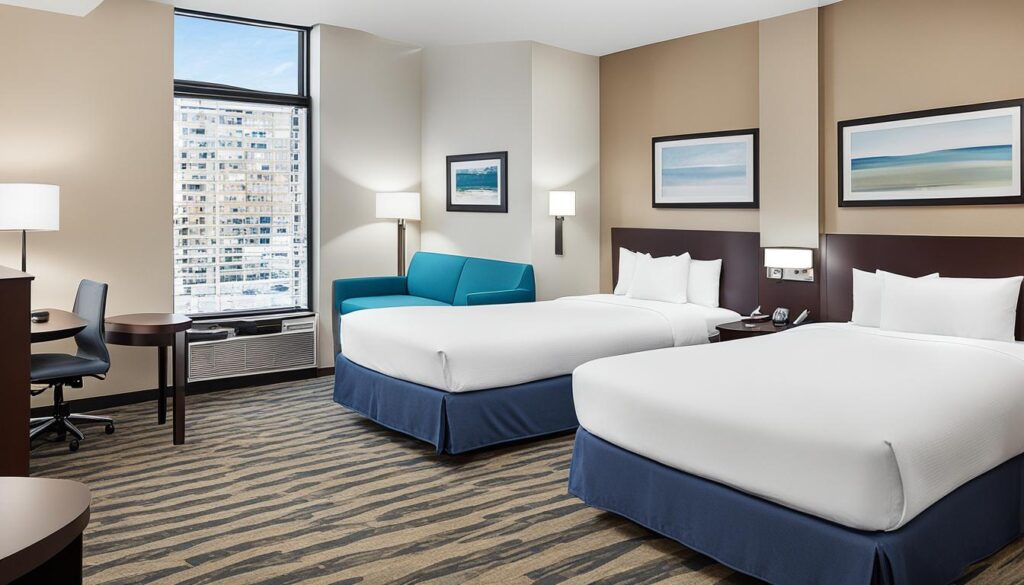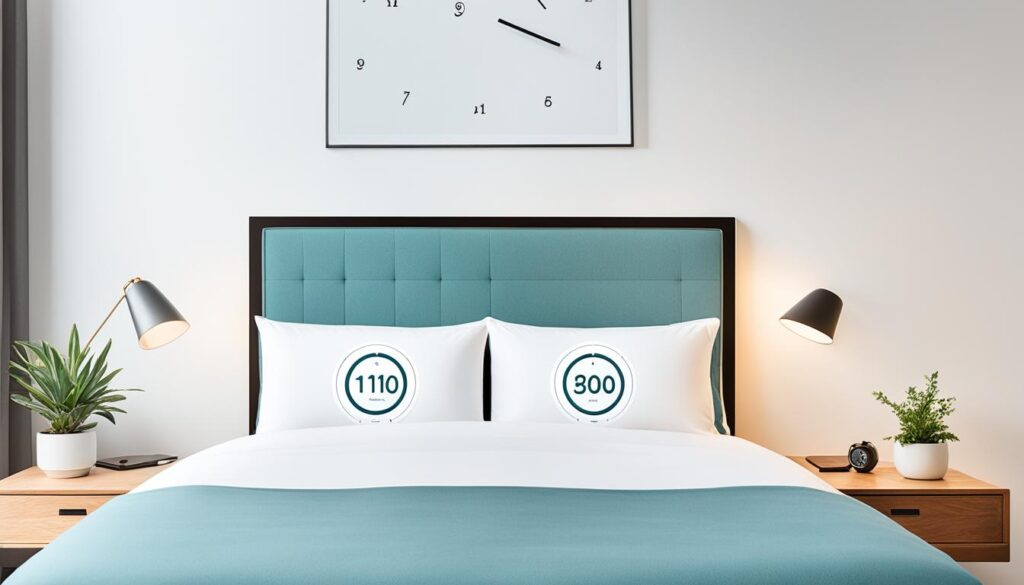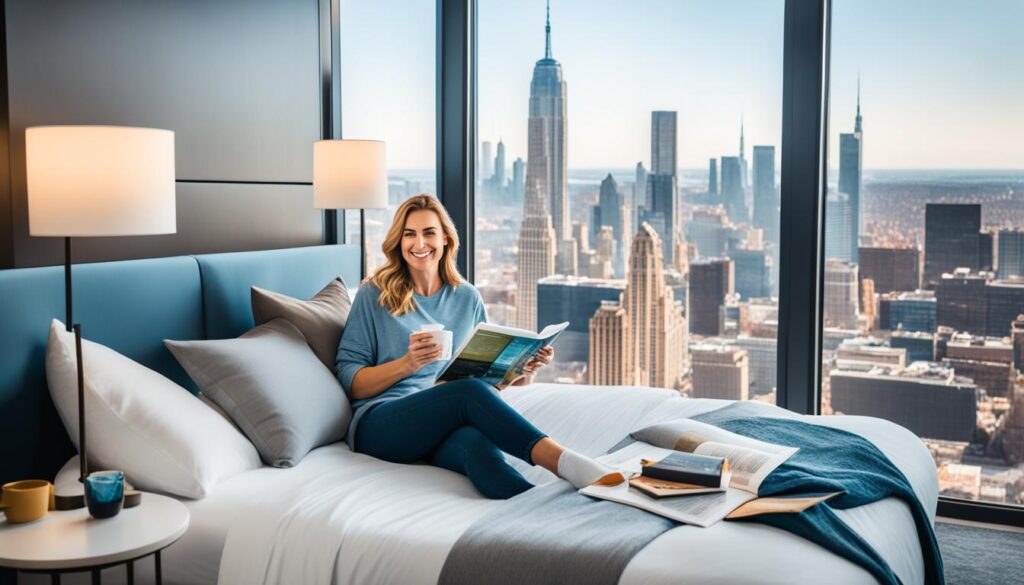Last Updated on: 23rd July 2024, 02:50 pm
The advent of Microstay Hotels signifies a remarkable shift in the accommodation landscape, offering both travelers and locals an innovative solution for flexible lodging. Unlike traditional hotel bookings, microstay accommodation allows guests to reserve rooms for short durations, typically ranging from three to twelve hours, providing a highly customizable option for short-term accommodation needs, including quick stays between layovers or a restful pause during a busy day1 . This unique model caters to various requirements, whether it’s a private space for a brief nap on a road trip or a tranquil environment to gather thoughts before a critical meeting.
The convenience of hourly hotel booking is revolutionizing traditional concepts of personal space away from home. For instance, many microstay hotels attract last-minute guests who book via mobile devices and need accommodations within 24 hours’ notice1. Micro stay options not only benefit the guest but also maximize hotel revenue by allowing the same room to be rented out multiple times a day1. These flexible solutions make short-term stays cost-effective and convenient for business travelers and leisure guests alike1.
With this comprehensive guide, we will explore the origins, benefits, and tips for making the most of quick stay hotels, standing as an invaluable resource for those looking to delve into microstay hotels.
Key Takeaways
- Microstay hotels offer the convenience of booking rooms on an hourly basis, perfect for short naps, layovers, or meeting prep.
- Guests can book rooms for three to twelve hours, accommodating various short-term lodging needs1.
- Microstays are an innovative and flexible alternative to traditional hotel stays1.
- Hotels can maximize revenue by renting the same room multiple times a day1.
- This accommodation model attracts last-minute guests, often booking via mobile devices within 24-hour notice1.
What is a Microstay Hotel
Microstay hotels redefine the concept of lodging by offering accommodations on an hourly basis rather than the traditional nightly rate. This flexible model caters to a wide range of travelers, from business professionals to leisure guests seeking a quick respite.
Definition of Microstay Hotels
A microstay hotel can be described as a cost-effective, space-efficient accommodation option that provides guests the flexibility of booking rooms by the hour. This type of lodging is ideal for those who need short-term lodging solutions, such as catching up on sleep during a layover or finding a quiet space for business tasks.
Microstays are particularly beneficial for business travelers who appreciate the hourly basis accommodation and the ability to book lodging for short periods, thereby paying only for the time they actually need1. Guests can book stays ranging from as little as three hours up to 12 hours, providing unparalleled flexibility1.
Origins and Popularity
The concept of microstay hotels has historical roots in Europe, particularly overcoming economic constraints post-2008 recession. The trend was significantly influenced by the Japanese capsule hotels, which were lauded for their efficient use of space and practical design for short-term stays. The idea was further popularized by platforms like BYHOURS, which has facilitated over 200,000 transactions since its inception in 2012, cementing the growing appeal of microstays2. Micro stays can attract last-minute guests, with a majority of bookings often made within 24 hours1.
Many luxury hotels, despite the estimated $22 daily cleaning cost for premium rooms, have also begun to see the potential revenue benefits of micro stays through effective booking systems introduced by platforms like BYHOURS and its counterparts2.
Types of Microstay Hotels
Micro stay hotels come in various forms to suit diverse needs and budgets. Capsule hotels, renowned in Japan, offer highly space-efficient sleeping pods that cater to solitary travelers seeking basic amenities in a minimalist environment. Pod Hotels follow a similar concept but often come with enhanced features, such as private bathrooms and entertainment systems, targeting a more contemporary audience.
Another noteworthy category is the day-stay hotels, which provide luxurious stays for a few hours, with full amenities comparable to traditional overnight accommodations. These establishments maximize revenue per room by booking the same room multiple times per day on an hourly basis1. By leveraging collaborations with local businesses, hotels can further enhance the overall guest experience and attract more visitors1.
To summarize, the microstay hotel sector is marked by versatility, catering to a wide range of traveler needs and redefining how we perceive and utilize short-term lodging options. Whether opting for a pod hotel, capsule hotel, or a day-stay establishment, travelers are provided with increasingly convenient and flexible accommodation choices.
Benefits of Microstay Hotels

Microstay hotels have emerged as a viable solution for travelers seeking flexibility and cost-effective travel solutions. These establishments cater to the modern demand for convenience in accommodation without sacrificing quality.
Cost-Effectiveness
One of the standout microstay benefits is the ability to pay only for the time you need. Guests can reserve rooms for three hours or more, making it a cost-effective travel solution compared to overnight stays which traditionally span 20 hours2. Many hotels even offer the same room twice in a single day, providing additional savings2. For example, a daytime stay in an Ibis hotel may cost only £60, whereas an overnight stay could be £1302. Additionally, the BYHOURS app has completed over 200,000 transactions, providing discounted rates to patrons opting for short stays2.
Flexibility and Convenience
The flexibility and convenience of micro stays cater to a broad range of needs, from layovers to business meetings. Travelers can check in at various times, offering a solution for those with long layovers or flight delays, allowing for a quick refresh before continuing their journey3. Business professionals often use microstay hotels to rest and prepare for meetings or presentations3. This flexible booking style is becoming increasingly popular as the demand for customized travel experiences grows2.
Target Audience
The target audience for microstay hotels is diverse, encompassing various demographics and trip purposes. Backpackers and trekkers utilize these accommodations for taking short naps and relaxing before resuming their adventures3. Families needing a comfortable stopover, corporate clients requiring a base for the day, and shoppers looking for a midday break all benefit from the convenience in accommodation offered by microstay hotels. Additionally, the provision of amenities in hourly hotels debunks the myth that only full-day bookings come with comfortable facilities3.
Whether you are in search of economical hotel stays or in dire need of a quick space to refresh, microstay hotels present a versatile and adaptable option to meet various travel needs.
Comparing Microstay Hotels to Traditional Hotel Stays

Traditional hotel stays typically require guests to book rooms on a nightly basis, while microstay hotels revolutionize this by offering time-specific booking options, even for as short as three hours4. This flexibility makes micro stay hotels an excellent choice for travelers seeking quick, adaptable accommodation alternatives. The microstay model is especially beneficial for those affected by the 25% flight delays in the US5.
When comparing microstay vs. overnight stay, the most significant difference is the level of flexibility afforded. While traditional hotel stays demand overnight bookings, microstays offer a cost-effective and time-efficient approach. This flexibility helps meet the varied needs of travelers, from those on layovers to business professionals needing temporary office space5.
The amenities offered by microstay hotels align closely with those of higher-star traditional hotel stays, providing comfort and quality despite the short durations. This is particularly evident in boutique hotels and independent hotels, which offer unique designs and themes while ensuring high comfort levels4. Additionally, resorts and apart-hotels combine a variety of facilities and traditional services to offer a comprehensive experience4.
The increasing trend towards flexible travel solutions is supported by the significant 60% growth in microstay hotel bookings in 20225. This trend highlights the growing appeal of microstay amenities among modern travelers. Traditional hotel stays remain valuable for extended experiences, but microstays provide unique flexibility and efficiency that accommodate the dynamic demands of today’s travelers5.
Overall, microstay hotels present a compelling alternative to traditional hotel stays. With customizable durations and comparable amenities, they cater to a diverse range of travel requirements. This dynamic accommodation model is not only an economic option but also a smart, flexible travel solution for various scenarios45.
Popular Microstay Booking Platforms

Exploring the landscape of micro stay hotels reveals a number of innovative platforms designed to simplify the booking process. These Microstay Booking Platforms offer seamless access to hourly stays, ensuring flexibility and convenience for modern travelers.
ByHours
ByHours is a trailblazer in the Microstay Booking Platform industry, enabling users to book hotel rooms in blocks of 3, 6, or 12 hours. Operating in multiple countries, it caters to business and leisure travelers alike, underlining the growing demand for flexibility that ByHours delivers1.
Dayuse
With its expansive reach across 25 countries, Dayuse offers a wide array of hotels for short-term accommodations1. This platform is particularly renowned for its user-friendly mobile interface, which aligns with the trend of travelers making last-minute bookings via mobile devices1.
DayBreakHotels
Specializing in day-use services, DayBreakHotels provides an array of options for those seeking respite or a workspace during the day. Collaborations with local businesses allow this platform to create targeted packages, enhancing the appeal for guests looking for additional value during their short stays1.
HotelsByDay
Targeting business travelers with needs for early check-ins and late check-outs, HotelsByDay offers the flexibility required for varied schedules. The platform leverages its user-friendly mobile app to ensure guest engagement and convenience, driving greater booking conversions1.
These platforms, including ByHours, Dayuse, DayBreakHotels, and HotelsByDay, exemplify the dynamic and responsive nature of Hourly Hotel Booking Platforms. By offering a flexible and convenient booking process, they cater to diverse traveler needs, ranging from quick refresh sessions to essential business endeavors.
Tips for Making the Most out of a Microstay Hotel

To optimize your microstay experience, here are several effective strategies.
Booking Strategies
Selecting the right platform for your microstay booking is crucial. Exploring options like BYHOURS, which has facilitated over 200,000 transactions, can significantly improve your odds of securing a room suited to your immediate needs2. Additionally, platforms accommodating last-minute bookings can strategically enhance the ease and flexibility of your travel plans.
Using Amenities
Maximizing micro stay hotels involves not just the room but the amenities available. For instance, utilizing hotel amenities like gyms, pools, and business centers can multiply the value of your brief stay, ensuring you make the most of every minute. This approach isn’t just about comfort—using these facilities effectively transforms a quick rest period into a well-rounded mini-experience.
Leveraging Local Partnerships
Many hotels have established local partnerships designed to enhance guest experiences. Take advantage of bundled packages that include discounts at nearby attractions or exclusive deals at excellent restaurants. By leveraging local partnerships in hospitality, microstay guests not only save money but also gain unique, enjoyable opportunities, maximizing the entire short-term stay.
In summary, adopting these microstay booking strategies, actively using hotel amenities, and leveraging local partnerships can significantly enhance the experience. Such strategic hotel booking approaches ensure that even the shortest visits are memorable and efficient.
Conclusion
Micro stay Hotels offer a groundbreaking alternative to traditional hotel stays, addressing the needs of contemporary travelers seeking flexibility and efficiency. By allowing guests to book rooms in hourly blocks, these establishments present an economical solution for Short-Term Hotel Stays, catering to various scenarios such as quick rest stops during road trips or private spaces between layovers.
The trend of Microstay Accommodation underscores a broader shift in consumer preferences towards personalized and adaptable travel solutions. The innovative model not only meets financial considerations but also introduces users to diverse amenities quickly and efficiently. For instance, micro hotels like ZIP by Premier Inn provide rooms averaging about 91 square feet, distinctly smaller compared to traditional hotel rooms that average around 330 square feet6. Such space efficiency is one of the standout Microstay Hotel Benefits.
Moreover, the incorporation of modern technology elevates guest experiences in these accommodations. Take Hilton’s Motto, where guests can control room settings via the Hilton Connect room app, enhancing convenience and personalization. Meanwhile, Moxy’s approach ensures 30% of interconnected rooms to cater to families and groups, blending lifestyle and practicality with social connectivity6. Additionally, engaged experiences are provided through various offerings; Arlo Hotels in New York, for example, feature yoga classes, boot camps, and live music events6.
Overall, Microstay Hotel models demonstrate significant potential for continuing innovation within the hospitality industry. From leveraging local partnerships to integrating advanced amenities seamlessly into their operations, these hotels embody the essence of Hourly Booking Insights. As consumer interest in Microstay Accommodation Trends grows, the rapid evolution in hospitality proves that microstays are not merely a fleeting trend but a lasting fixture in modern travel and lodging solutions. For further insights into how microstays are transforming the industry, read detailed analyses on Hospitality Net.
FAQ
What exactly is a Microstay Hotel?
How does a Microstay differ from a traditional hotel stay?
What are the main benefits of choosing a Microstay Hotel?
Where did the concept of Microstay Hotels originate?
Who can benefit from Microstay Hotels?
Are there different types of Microstay Hotels?
What amenities can I expect in a Microstay Hotel?
How do I book a Microstay Hotel?
What strategies can enhance my Microstay Hotel experience?
Source Links
- https://www.littlehotelier.com/blog/increase-your-revenue/using-micro-stays-bb-keep-ahead/
- https://www.aetnainternational.com/en/about-us/explore/living-abroad/travel/rise-of-microstays.html
- https://medium.com/@wowkuldeep11/lets-talk-about-benefit-of-micro-stay-fb2752725ffc
- https://www.bigfoothospitality.com/post/various-types-of-hotels
- https://www.peeryhotel.com/can-you-book-hotels-for-a-few-hours/
- https://www.hospitalitynet.org/opinion/4095107.html
Aparthotel Glossary

As a passionate, global-thinking Real Estate Investor I am constantly looking for the best opportunities to invest in Properties. With Aparthotel.com I am building an All-In-One Global Real Estate Platform, where people can analyse, rent or invest in properties. Additionally I help Investors with comparing the best financing options as well as give detailed Consultation on the buying process for Real Estate Investments around the world. I am looking forward to sharing my knowledge on this Website and feel free to reach out to me if you have any questions.

Comments